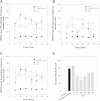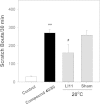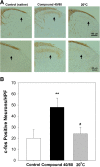Antipruritic effect of cold stimulation at the Quchi acupoint (LI11) in mice
- PMID: 25239797
- PMCID: PMC4179855
- DOI: 10.1186/1472-6882-14-341
Antipruritic effect of cold stimulation at the Quchi acupoint (LI11) in mice
Abstract
Background: Acupuncture and moxibustion are used to treat pruritus and atopic dermatitis. However, whether cold stimulation (defined as that the temperature conducted under skin temperature) of acupoints affects itching in experimental murine models remains unclear.
Methods: The present study was designed to determine the therapeutic effects of different thermal stimulations at the Quchi acupoint (LI11) in a murine model in which scratching behaviour was elicited by subcutaneous injection with a pruritogenic agent (compound 48/80). Male ICR mice were divided into several groups as follows: control (saline), those receiving compound 48/80 and compound 48/80 with various thermal stimulations (5°C-45°C) at LI11 (n = 6 per group). The scratch response of each animal to these stimulations was recorded for 30 min. The antipruritic effect of the acupoint was further evaluated in LI11 and sham (non-acupoint) groups (n = 6 per group).
Results: Treatment with lower temperature (20°C) at the LI11 acupoint significantly attenuated compound 48/80-induced scratching; however, this antipruritic effect was not observed with stimulation at the sham point. The expression of c-fos in the neuron of the cervical spine induced by compound 48/80 was suppressed by cold stimulation at LI11. The antipruritic effect of cold stimulation was blocked by ruthium red (RR), a non-selective transient receptor potential (TRP) channel blocker, suggesting that TRP channels may play an important role in the antipruritic effect of cold stimulation at LI11 in mice.
Conclusions: This study demonstrated that cold stimulation at LI11 attenuated compound 48/80-induced scratching behaviour in mice, possibly by a TRP-related pathway.
Figures





Similar articles
-
Manual acupuncture relieves bile acid-induced itch in mice: the role of microglia and TNF-α.Int J Med Sci. 2018 Jun 13;15(9):953-960. doi: 10.7150/ijms.24146. eCollection 2018. Int J Med Sci. 2018. PMID: 30008609 Free PMC article.
-
Acupuncture at heterotopic acupoints enhances jejunal motility in constipated and diarrheic rats.World J Gastroenterol. 2014 Dec 28;20(48):18271-83. doi: 10.3748/wjg.v20.i48.18271. World J Gastroenterol. 2014. PMID: 25561794 Free PMC article.
-
Acupuncture in haemodialysis patients at the Quchi (LI11) acupoint for refractory uraemic pruritus.Nephrol Dial Transplant. 2005 Sep;20(9):1912-5. doi: 10.1093/ndt/gfh955. Epub 2005 Jun 28. Nephrol Dial Transplant. 2005. PMID: 15985509 Clinical Trial.
-
Methods for preclinical assessment of antipruritic agents and itch mechanisms independent of mast-cell histamine.Biol Pharm Bull. 2015;38(5):635-44. doi: 10.1248/bpb.b15-00090. Biol Pharm Bull. 2015. PMID: 25947907 Review.
-
Device-based physical therapies in chronic pruritus: A narrative review.J Am Acad Dermatol. 2024 Oct;91(4):699-705. doi: 10.1016/j.jaad.2024.06.045. Epub 2024 Jun 29. J Am Acad Dermatol. 2024. PMID: 38950710 Review.
Cited by
-
Comparative Study of Classical and Alternative Therapy in Dogs with Allergies.Animals (Basel). 2022 Jul 19;12(14):1832. doi: 10.3390/ani12141832. Animals (Basel). 2022. PMID: 35883379 Free PMC article.
-
Efficacy of acupoint stimulation as a treatment for uremic pruritus: A systematic review and meta-analysis.Front Med (Lausanne). 2022 Dec 1;9:1036072. doi: 10.3389/fmed.2022.1036072. eCollection 2022. Front Med (Lausanne). 2022. PMID: 36530891 Free PMC article.
-
Efficacy of Acupuncture in Itch: A Systematic Review and Meta-Analysis of Clinical Randomized Controlled Trials.Evid Based Complement Alternat Med. 2015;2015:208690. doi: 10.1155/2015/208690. Epub 2015 Apr 30. Evid Based Complement Alternat Med. 2015. PMID: 26064156 Free PMC article. Review.
References
-
- Carlsson CP, Wallengren J. Therapeutic and experimental therapeutic studies on acupuncture and itch: review of the literature. J Eur Acad Dermatol Venereol. 2010;24(9):1013–1016. - PubMed
Pre-publication history
-
- The pre-publication history for this paper can be accessed here:http://www.biomedcentral.com/1472-6882/14/341/prepub
Publication types
MeSH terms
Substances
LinkOut - more resources
Full Text Sources
Other Literature Sources
Medical

